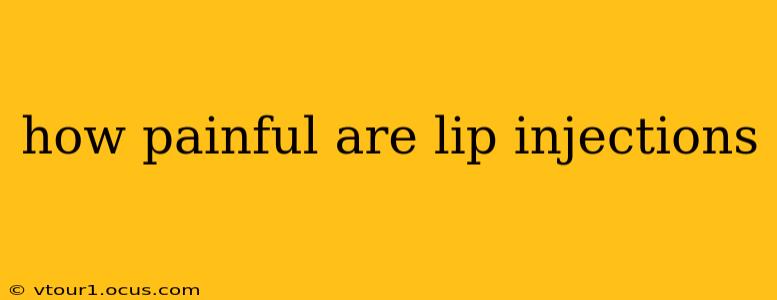Lip injections have become increasingly popular as a non-surgical cosmetic procedure to enhance lip fullness and shape. While the results can be dramatically improving, many potential patients are understandably concerned about the pain level involved. The truth is, the pain experience is subjective and varies significantly from person to person. This comprehensive guide will explore the factors influencing pain perception during lip injections and offer strategies to minimize discomfort.
What to Expect During the Procedure
The procedure itself is relatively quick, usually taking around 15-30 minutes. A numbing cream is typically applied to the lips before the injection to minimize discomfort. The injections themselves involve very fine needles, and most patients describe the sensation as a series of quick pinches or stings rather than continuous, throbbing pain. Some describe the feeling as similar to a bee sting, albeit brief.
How Painful Are Lip Injections, Really?
The pain level during lip injections is largely dependent on several factors:
-
Individual Pain Tolerance: This is the most significant factor. Some individuals have a naturally higher pain tolerance than others, making the procedure much more comfortable.
-
The Injector's Skill and Technique: An experienced injector is adept at minimizing pain by using precise injection techniques and applying the numbing cream effectively. A skilled injector will also understand the lip's anatomy to ensure injections are placed strategically to reduce discomfort and maximize results.
-
Type of Filler Used: Different filler types may have slightly varying injection experiences. Some fillers are formulated with lidocaine, a local anesthetic, which further reduces pain during the procedure.
-
Injection Site: Some areas of the lips are more sensitive than others. The injection site can affect the overall experience.
-
Anxiety Levels: Pre-procedure anxiety can heighten pain perception. Relaxation techniques can help to alleviate this.
What Can I Do to Minimize Discomfort?
Several strategies can help to minimize discomfort during lip injections:
-
Choose an Experienced Injector: Researching and selecting a qualified and experienced injector is crucial. Look for board-certified dermatologists, plastic surgeons, or other medical professionals specializing in cosmetic injectables. Read reviews and check their credentials.
-
Discuss Your Concerns with Your Injector: Open communication with your injector is vital. Discuss your concerns about pain and any previous experiences with injections. They can address your anxieties and explain the procedure in detail, which can help alleviate some of your apprehension.
-
Use Pain Relief Techniques: Deep breathing exercises, meditation, or listening to calming music can help you relax and manage anxiety before and during the procedure.
-
Consider Over-the-Counter Pain Relief: Your injector may advise taking an over-the-counter pain reliever, such as ibuprofen, before the procedure. This may reduce sensitivity.
What Does It Feel Like After the Injection?
Following the procedure, you may experience some mild swelling, bruising, or tenderness. This is generally temporary and resolves within a few days. Over-the-counter pain relievers can help manage any lingering discomfort. Ice packs can also help reduce swelling.
Are There Alternatives to Reduce Pain?
Some injectors offer options to further minimize pain. These could include:
-
More potent numbing cream: Some practices utilize stronger numbing agents to provide increased comfort.
-
Ice application prior to injection: Pre-cooling the lips can temporarily numb the area.
-
Use of a vibrating device: Some injectors use a vibrating device to help minimize the pain sensation.
Is it Worth the Potential Discomfort?
Ultimately, whether the potential discomfort is "worth it" is a highly personal decision. Weigh the potential benefits of fuller, more shapely lips against your personal pain tolerance and anxiety levels. Honest communication with your injector will help you make an informed choice.
Are lip injections permanent?
No, lip injections are not permanent. The effects of lip fillers typically last for several months, varying depending on the type of filler used and individual metabolism. Top-ups are usually required to maintain the desired results.
What are the risks involved in lip injections?
As with any medical procedure, there are potential risks associated with lip injections. These include bruising, swelling, infection, and allergic reactions. However, these risks are generally minimized when the procedure is performed by a qualified and experienced medical professional. Always discuss potential risks with your injector before proceeding.
By carefully considering these factors and employing strategies to manage discomfort, many patients find the experience of lip injections to be manageable and ultimately rewarding. Remember, communication with your injector is key to a positive and comfortable experience.
